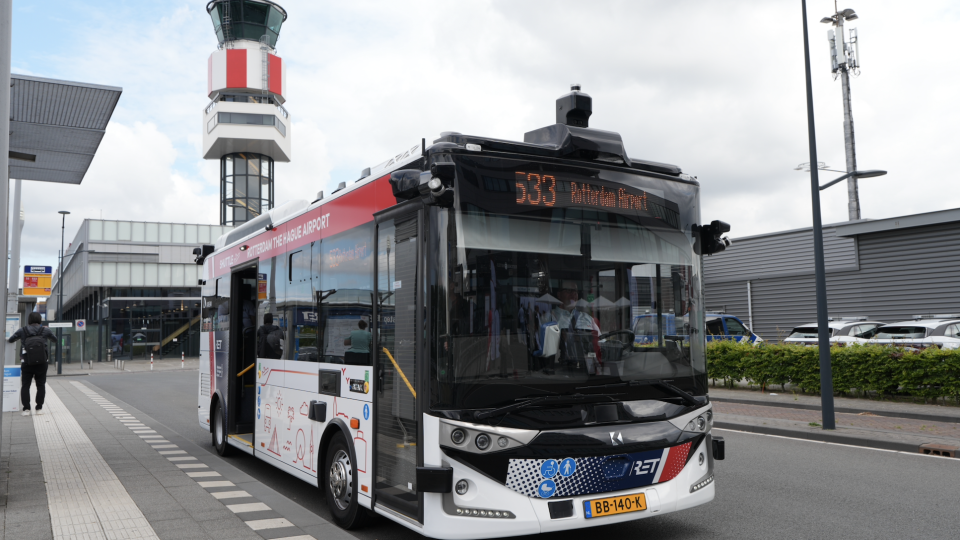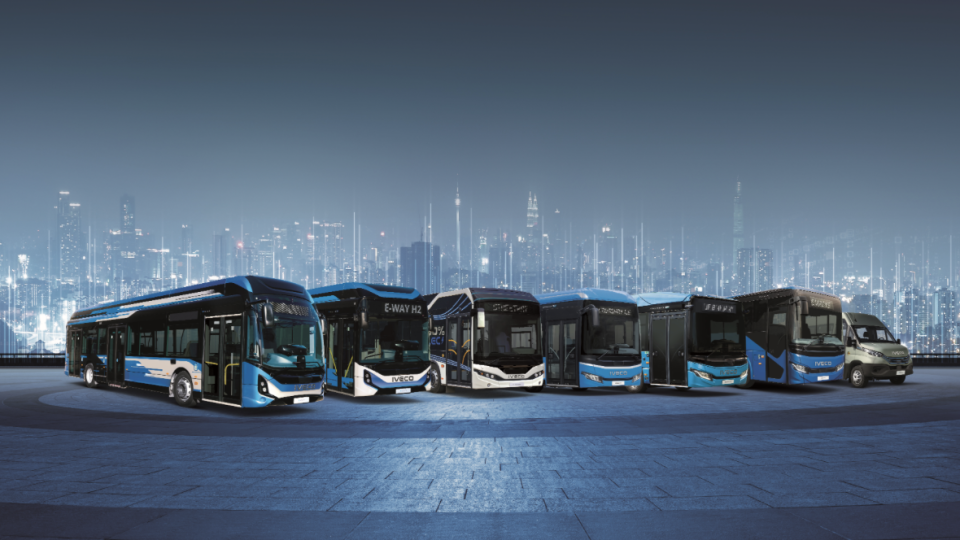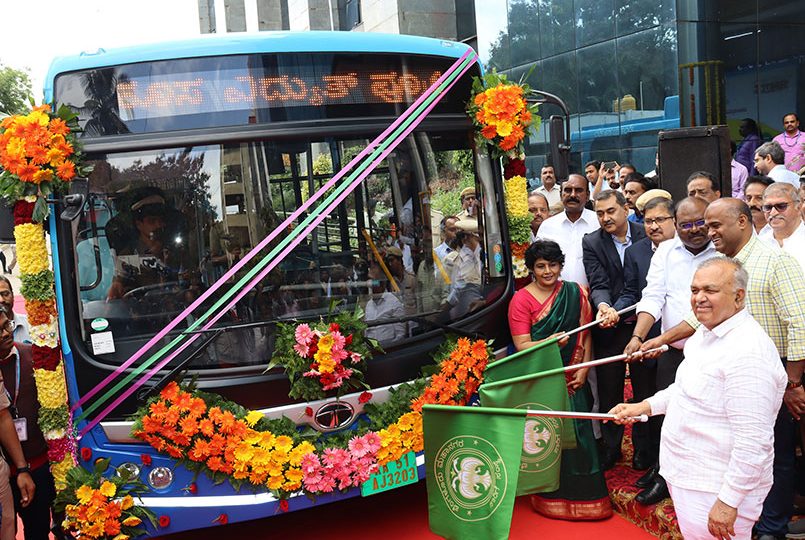For Rampini it’s the first time at Busworld. World premiere for the 8-meter H2-powered Hydron
Italian bus builder Rampini participates for the first time in its history in Busworld Europe in Brussels and shows its full portfolio of Zero Emission buses in a compact size. The highlight is the presentation of the new Hydrogen Range Extender midibus Hydron, that goes into production in 2024. Also the electric version of the […]
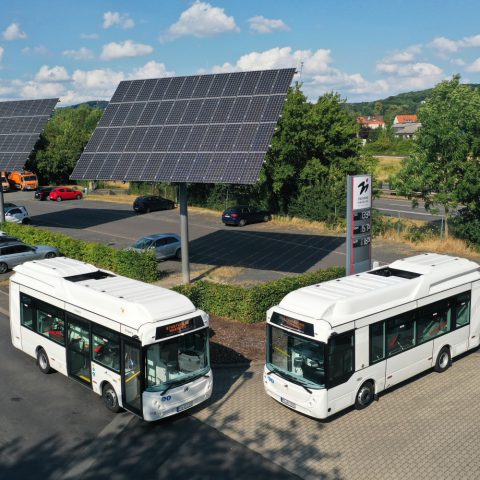
Italian bus builder Rampini participates for the first time in its history in Busworld Europe in Brussels and shows its full portfolio of Zero Emission buses in a compact size. The highlight is the presentation of the new Hydrogen Range Extender midibus Hydron, that goes into production in 2024.
Also the electric version of the eight meter Midibus Eltron is featured with a new Design called “Stile Energetico”, made by the prestigious Italian Design Studio Vernacchia.
Last but not least the smallest family member with six meters length joins the show: the SIXTRON for up to 28 passengers – also fully electric.
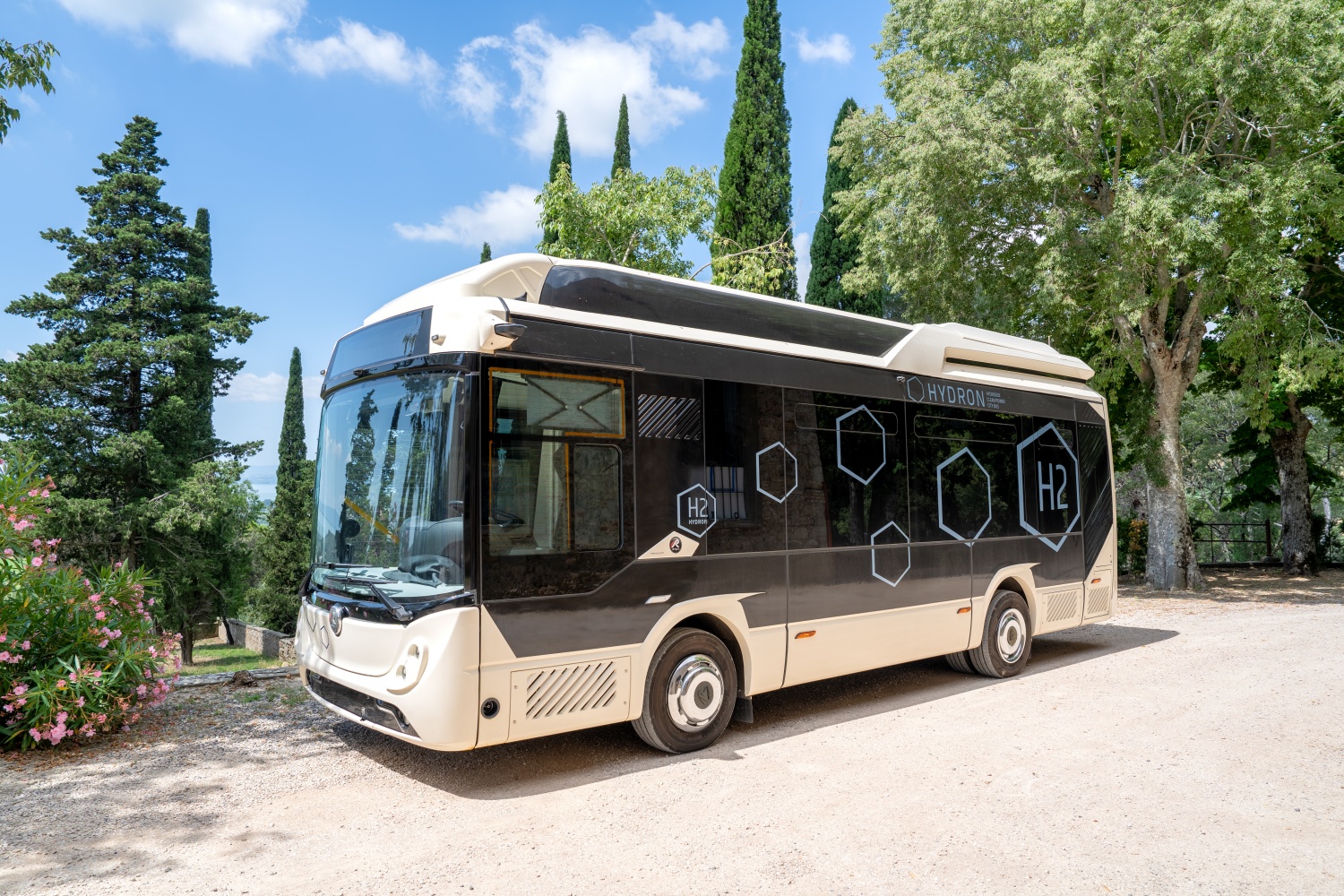
The world premiere of Rampini Hydron at Busworld
Rampini is the first manufacturer to offer a compact Midibus with a well-sized battery and a hydrogen range extender to combine the best of both worlds.
Rampini ELTRON and Hydron are not completely different models, but rather “two sides of the green Zero Emission Coin”, with most parts and concepts shared among each other: body concept, Stile Energetico-Design, Driveline, Interior design etc.
One difference, the Hydron is offered only in a two-door-version unlike the ELTRON, which is also available with three doors.
On the Hydron a smaller sized battery pack (175 kWh net instead of 270 kWh) is supported by a compact 30 kW fuel cell by the Canadian manufacturer Loop Energy. Due to the innovative eFlow architecture of the company, the fuel cells offer a 16 percent lower consumption of precious hydrogen while at the same time boasting up to 90 percent higher peak power and ten times better current density uniformity with the same stack size, Rampini states.
The fuel cell has a very conservatively estimated, 10.000 hours lifespan and so matches the intermittent usage of the cell. It has a preheating for winter, and can be started even in very cold weather after a short waiting time. The three Luxfer Type 3 flasks with 350 bar pressure hold ca. 15 kg of hydrogen in a modular frame, that is also interchangeable with the ELTRON roof installations. With this amount of Grade D Hydrogen, the Hydron is able to extend its range to more than 400 kilometers in E-SORT 1 and almost over 500 kilometers in E-SORT 2 without heating or A/C, Rampini says. With Hydrogen alone the range can reach also 250 kilometers, what should be enough for a days service in most cases.
Due to a partnership with the Italian gas supplier Sapio, Rampini is also able to support customers in the setup of their own hydrogen fuel station. The manufacturer has installed such a filling station on its factory premises in Passignano himself recently.

Rampini HyDrive technology: what is about?
The “Hy4Drive”-System is a electronic Drive Management System for the Hydrogen Bus Hydron, completely developed in-house by the technicians of Rampini. It offers four different modes of usage of the fuel cell and thus of the whole Drive System. The modes can be individually chosen by the driver in the vehicle System or the systems choses them automatically in case of a malfunction or of low battery energy. Generally, the fuel cell can be activated only under 90 percent E-SOC and runs with low power between 90 and 93 percent E-SOC.
The four modes of Hy4Drive are defined as such, in the words of Rampini itself:
Range Extender: Designed to maximize daily mileage using energy normally in proportion 40 percent battery and 60 percent Hydrogen energy, which equals the proportion of total on-board energy. Also is it possible to activate a “Pulse-Mode” of the fuel cell with given time slots, when it working or not. This is the ideal mode of driving to reach the best possible range, using battery as well as fuel cell Energy. The fuel cell alone can fill the battery up to 80 percent E-SOC (Electric State of Charge) in about 4 hours and 40 minutes, compared to 6 hours and 60 minutes with a 22 kW external charger. In case of high power demand or when the E-SOC falls below 20 percent, the fuel cell is set into a boost mode to deliver maximum power. Thus the Range of the Hydron is minimum 100 km higher than that of the BEV ELTRON in E-Sort 1.
Pure Hydrogen: In this mode all energy comes from the stored Hydrogen (stored gaseous at 350 bar pressure). The LFP-batteries have only a peek shaving function during acceleration and also a buffer function for storing regenerative braking (recuperation). State of Charge of Battery (E-SOC) is always kept around 90 percent and the fuel cell power can be manually adjusted between 50 and 100 percent. This mode is ideal, if the vehicle is supposed to run on the Batteries in the next service cycle.
Pure Electric: In this Mode all energy comes from the 170 kWh-Traction battery only. The fuel cell is kept always offline and the vehicle is operated like a normal BEV. This mode is ideal, when the Hydrogen storage is empty or other reasons are there, not to fill up the Hydrogen tanks. Also in winter this mode is ideal, as the emitted water of the fuel cell could freeze on the street or in a bus stop, where the vehicle is idling for some time.
Hybrid Custom: In this mode it is possible to customize exactly how much energy is drawn from the 170 kWh Traction-battery respectively from the 30 kW-fuel cell to allow adapting the usage according to the actual depot- and infrastructure-capability. In this way the service and range of the Hydron can be adjusted tailormade to the daily service needs. This is the most sophisticated mode of the System and needs some skills and close consideration of the depot management.
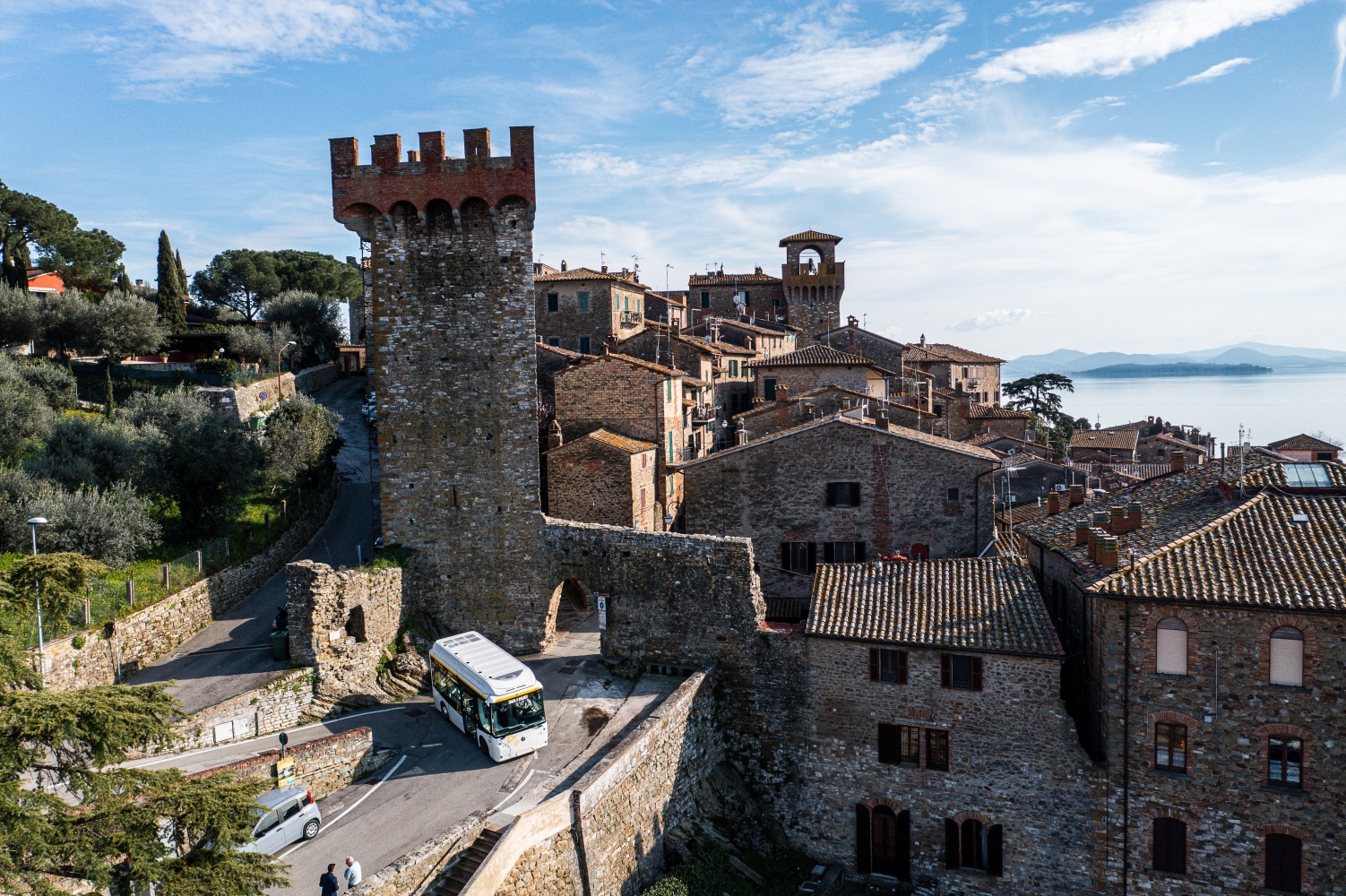
Rampini Eltron, here it comes the new design
The ELTRON is a classic full low-floor midibus in integral design, available as a two- or three-door version with barrier-free wheelchair space. Thanks to its length and width (only 2.20 metres) as well as the small wheelbase and a record-breaking turning circle of only 14.8 metres, the minibus is ideally suited for narrow city centres and historic old towns.
All batteries and most electrical components are installed on the roof, so there is no classic power unit tower in the rear that costs seats.
Therefore, the bus can accommodate ten (three-door) or 13 (two-door) seated passengers, for a total of 46/48 without wheelchair space, 43/45 with wheelchair space. Like a full low-floor city bus, the ELTRON is of course barrier-free and equipped with a manual folding ramp. An optimal midibus concept that no other Central European busbuilder has in its programme in this form.
The new Rampini ELTRON (as well as the Hydron) has been given a completely new design.
The 10 respectively 13 comfortable seats can of course be individually selected and are optimally upholstered for typical city lines. Special attention deserves the separate passenger compartment air conditioning that incorporates an infrared heating system “TopHeat” in the interior ceiling, which quickly and efficiently supplies radiant heat (max. 800 watts) to passengers who spend only a short time in the standing platform, but without escaping again through the large swinging doors at each stop. An important component of the ELTRON’s efficiency strategy to realize an optimal range.
The VDV compliant (for Germany) cockpit of the bus is very clearly laid out and functional, the dashboard by the Swiss manufacturer TEQ is the defining element and stands out as a solitaire. TEQ also supplies the electronic multiplex system as well as the full telematics connectivity (“Teq Monitoring”) of the bus.
Below Rampini Eltron’s bonnet
For the new ELTRON, Rampini has opted for a vehicle-mounted central motor that operates for the first time according to the highly efficient permanent-manget synchronous principle (PSM) with three phases, which transmits its power to a conventional axle differential via a matching gearbox that was developed in-house and is also new – all of this continuously variable and up to 7,000 revolutions per minute.
The peak power of the compact, water-cooled engine from Dana (TM4) is 235 kW/320 hp, the continuous power 133 kW/180 hp. The maximum torque is available from the first revolution of the copper coils with up to 950 Newton metres (directly at the engine, but not at the wheel). With an permissible total weight of 12,000 kg, this engine is by far sufficient and can meet all the requirements of city traffic.
The independent suspension of the front axle is based on the ZF RL 55 EC and was specially adapted for this application. For the driver in particular, this type of suspension is very comfortable and is part of the stationary wheel repertoire of a premium bus in Europe. In combination with the sensitive electro-hydraulic steering from Elica, the result is a superior driving experience that would also suit many a large bus.
The rear axle is engineered in-house, designed according to the hypoid principle and adapted in dimension to that of the bus. It is available in a standard ratio, optimal for most applications for the bus. The modern ECAS 3.0 levelling system is also installed on board, as is the new EBS 3 electronic braking system, which fully integrates all electronic braking systems and is also prepared for future functions.
Energy storage is at least as essential for a high-quality electric bus as the drive. With its maximum 281 kWh (alternatively 210 kWh, if charging pantographs are fitted) of battery capacity (80 percent of which can be used and is distributed over eight modules on the roof) and a range of up to 300 kilometers (e-SORT 2 without heating or air conditioning), the ELTRON offers more than any other supplier on the European market. In the “worst case” with e-SORT 1 and heating or air conditioning, the range is still at least 200 kilometers.
Batteries are now supplied by world market leader CATL from China completely as finished modules. Energy density has been increased from 100 to 180 Wh/kg. In case of installation of vehicle-mounted or infrastructure-mounted pantographs, the battery capacity is reduced to 210 kWh in six modules. Rampini assumes a battery life of six to eight years (depending on use and maintenance) and therefore provides a warranty of at least five years.
The shortest in the family: Rampini Sixtron
The smallest product of the company is the six meter long and only 2,1 meter wide Minibus SIXTRON, that is suited perfectly for small inner cities or historic centres. The vehicle is designed with an integral bus body.
The maximum of 28 passengers (without wheelchair space) can enter via a big sliding door of 1,34 m width with an entrance height of 340 mm, the standard for low floor buses. Thanks to a wheelbase of 3,7 meter the turning circle is a astonishing 14 meters small – optimal for the most densely built cities and corners. In the interior the passengers find a easy to clean low floor design, the drivers compartment is separated with a door and therefore resistant to every kind of vandalism. In the passenger area there are ten comfortable city seats, up to 17 people can be standees (without wheelchair, for which a manual ramp would be installed).
The driveline of the vehicle with a total permissive mass of 8,8 tons equals that of bigger models with its central synchronous PSM e-Motor with a peak power of 230 kW and a peak torque of 950 Nm. The robust and safe LFP-battery pack on the roof with a massive 210 kWh of capacity is good for a range of up to 250 kilometers in E-SORT1, the charging of the bus at 22 kW takes around 4,5 hours. The safety of the SIXTRON is also at par with its bigger brothers: the comfortable independent ZF front suspension is as self-evident as ESP and optional MirrorView Cams. Also all regulations of the new European General Safety Regulation (GSR) will be naturally fulfilled when the regulation becomes mandatory mid 2024.
The history of Rampini
Founded in 1945, the company started off with the maintenance and development of common and special vehicles. During the time other fields of expertise like industrial machinery and process competences extended the portfolio of the company, which has grown quickly in turnover and size. Today Hi-Tech equipment like Iron Rollers for the famous “Pistenbullis” preparing skiing areas in the alps are produced from Rampini as well as diverse equipment like Energy Stations and other Hi-Tech special equipments for the defense sector. The industrial portfolio is therefore very diversified.
Rampini has been committed to the theme of decarbonisation of municipal transport and waste disposal as well as the electrification of commercial vehicles since the early 2000s.
Since then, around 200 electric buses have left the factory halls in Passignano and have been delivered to six European countries – Germany, France, Austria, Spain and Greece in addition to Italy. In May 2023, the company won part of the large Consip tender one of the company’s biggest sales successes to date.
Since 2022, the next generation of the family has joined the management: Caterina Rampini as CEO and Vice President, and Andrea Rampini as CEO and R&D Manager. This also marks the beginning of a new era for the company, which employs around 100 people.




